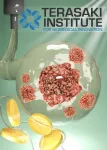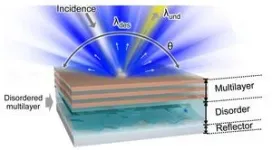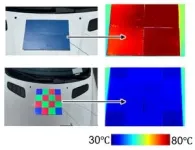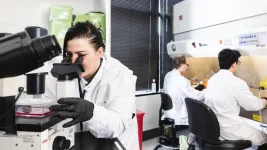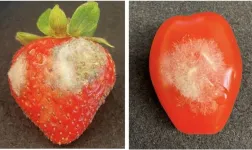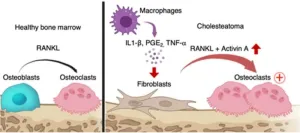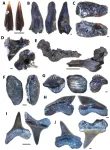(Press-News.org) (LOS ANGELES) – August 3, 2023 - Scientists from the Terasaki Institute for Biomedical Innovation (TIBI) have developed a nanoengineered bioink with improved bonding and cross-linking capabilities for 3D bioprinting of tumor models. A key component of this bioink is Laponite, highly charged, disk-shaped, crystalline nanoparticles. As explained in their recent paper in Biofabrication, these nanoparticles were shown to enhance the biological signaling that occurs in the tumor microenvironment so that more accurate tumor models can be created for study and anti-tumor drug development.
Tumor microenvironments are complex, with a supportive, connective tissue matrix containing multiple cellular components such as tumor cells, immune cells, organ specific cells, and collagen-producing cancer-associated fibroblasts. In addition, there is extensive cell-to-cell physical interaction and interactive signaling via a variety of biological factors that are difficult to model in an accurate and representative manner.
The use of 3D bioprinting offers a versatile approach for creating in vitro tumor models where precise 3D tissue structures can be created. To create an in vitro model, the printers use a cell laden biomaterial solution termed bioink custom made for the intended tissues. The bioinks in this study were comprised of cancer and normal cells from the tumor microenvironment, which were embedded in a biocompatible gel, typically a type of polymer. This cellular/gel mixture must be optimally formulated to exhibit mechanical and biofunctional properties that accurately recapitulate the tumor microenvironment.
In order to achieve these properties, the TIBI team chose gelatin methacyloyl (GelMA) as the polymer base for their bioink, a biocompatible material with tunable properties for structural stability and porosity, with binding sites conducive to cellular adhesion and survival. Adding Laponite to the GelMA not only created a reinforced network within the bioink, but also improved printability by conferring shear-thinning properties - the ability to deform under stress and then quickly self-recover. While using higher concentrations of GelMA and Laponite, the team was able to create bioinks with significantly improved shear-thinning properties.
In initial tests of their new composite as a biomaterial for the fabrication of a tumor model, the scientists made different GelMA/Laponite formulations and used them to encapsulate human pancreatic cancer cells. The formulations which gave optimum cell viability were identified and used in creating 3D bioprinted multicellular tumor models.
These multicellular models were made by adding fibroblasts, cells which are pivotal to pancreatic cancer tumor progression, to the GelMA/Laponite/pancreatic cell bioink. Tests of these models showed that the cells had good viability, particularly with higher Laponite concentrations. Furthermore, higher concentrations of Laponite were also observed to increase the size and distribution of co-aggregations of the two cell types; this more fully depicts the native pancreatic tumor structure and its promotion of cell-to-cell interactions.
The team went on to study the effects of Laponite on the gene expression of various biomarkers which are promoters or indicators of tumor progression in pancreatic cancer. They found that increased Laponite concentrations upregulated production of tumor cell growth factors, as well as remodeling and cell differentiation genes, by 10-20-fold.
The effect of Laponite on gene expression was even more pronounced on the fibroblasts, with overall upregulation of their gene pools, especially for genes related to growth factors, which were increased up to 60-fold. As fibroblasts play an important role in pancreatic tumor progression via signaling by these growth factors, this is a significant demonstration of Laponite’s influence.
The improved signaling between cancer cells and fibroblasts by released biological factors also increased the expression of genes that are related to the cell cycle – specifically, genes that indicate a decrease in the proliferation of cancer cells. The decrease in the proliferation of cancer cells is known as cancer dormancy, which is one of the factors affecting resistance to chemotherapy and cancer recurrence after treatment.
“Our study of the effects of Laponite on 3D printed tumor models has shown that not only does Laponite improve the mechanical characteristics of the model, but it can also selectively influence the biological signaling that are a part of tumor progression,” said Ali Khademhosseini, Ph.D., TIBI’s Director and CEO. “This gives us the versatility to re-create more accurate tumor models of different types so that targets for effective therapeutic drugs can be identified.”
Authors are: Natan Roberto de Barros, Alejandro Gomez, Menekse Ermis, Natashya Falcone, Reihaneh Haghniaz, Patric Young, Yaqi Gao, Albert-Fred Aquino, Siyuan Li, Siyi Niu, RunRun Chen, Shuyi Huang, Yangzhi Zhu, Payam Eliahoo, Arthur Sun, Danial Khorsandi, Jinjoo Kim Jonathan Kelber, Ali Khademhosseini, Han-Jun Kim, and Bingbing Li.
Funding provided by: The National Institutes of Health (HL140951, HL137193, CA257558, DK130566). This research is supported by the fundings of “Autonomy Research Center for STEAHM” sponsored through the U.S. NASA MUREP Institutional Research Opportunity (MIRO) program (80NSSC19M0200), “California Advanced Defense Ecosystem and National Consortia Effort (CADENCE)” sponsored through the U.S. DOD Defense Manufacturing Community Support Program (DMCSP) program (MCS1292-20-01), and “Collaborative Research: Creating an Upper Division Additive Manufacturing Course and Laboratory for Enhancing Undergraduate Research and Innovation” sponsored through the U.S. NSF Improving Undergraduate STEM Education (IUSE) program (1712391). This work is also supported by California State University Northridge College of Science and Mathematics; Sidney Stern Memorial Trust (to J.A.K.); Sutter family (to J.A.K); Aylozyan Family Foundation (to J.A.K.); and NIH NIGMS grant SC1GM121182 (to J.A.K.)
###
About the Terasaki Institute for Biomedical Innovation
The Terasaki Institute for Biomedical Innovation is accelerating the pace of translational research by supporting the world’s leading scientists with an open, entrepreneurial environment for bioengineering new materials, biological models, and advanced technologies to address critical challenges to the health of the planet and its people. The Institute’s worldwide collaborations with academic, clinical, and entrepreneurial partners provide a rich foundation for translating innovations to the real world.
TIBI Contact:
Stewart Han
President
Terasaki Institute for Biomedical Innovation
shan@terasaki.org
END
Enhanced tumor modeling using Laponite bioinks for 3D bioprinting
2023-08-03
ELSE PRESS RELEASES FROM THIS DATE:
Sharing on Facebook reveals 2 very different news environments
2023-08-03
COLUMBUS, Ohio – A first-of-its-kind study examined 2.2 million news stories shared on Facebook and found that publishers create two very different news environments.
These distinct ecosystems involve low-credibility publishers – those that publish what is sometimes referred to as fake news – versus high-credibility publishers.
Findings showed that while these two types of publishers often pushed out bursts of coverage at the same time – a common feature of news coverage – they were often about different topics, said Kelly Garrett, senior author of the study and professor of communication at The Ohio State University.
“These ...
The Access to Advanced Health Institute receives $18 million award to develop a temperature stable, single-dose chikungunya RNA vaccine through a phase 1 clinical trial
2023-08-03
The Access to Advanced Health Institute Receives $18 Million Award to Develop a Temperature Stable, Single-Dose Chikungunya RNA Vaccine Through a Phase 1 Clinical Trial
KEY POINTS:
The goal of the award is to develop an effective chikungunya vaccine candidate that can reach endemic areas of the world by using AAHI’s innovative RNA platform technology.
The project will demonstrate that classic large-scale manufacturing challenges of live-attenuated vaccines can be overcome by using standard manufacturing equipment and techniques that are easy to tech transfer and scale.
The award supports a first-in-human clinical trial of a dried (lyophilized) ...
A path to defeating crop-killing gray mold without toxic chemicals
2023-08-03
It’s a mold that causes billions in crop losses every year, infecting berries, tomatoes and most other fruits and vegetables. Now, researchers have found a way to defeat the mold without showering toxic chemicals on the crops.
If you’ve ever seen a fuzzy gray strawberry, you’ve seen gray mold. It affects more than 1,400 different plant species, and there is no real cure for it. Being able to control it may hinge on the discovery of lipid “bubbles” secreted by the ...
Disparities in Black adults’ stroke risk factors persist; risk factor control reduced gap
2023-08-03
Research Highlights:
In a retrospective analysis of stroke patients, Black adults who had a stroke due to a severe blockage of a major artery in the brain (intracranial atherosclerotic stenosis) were younger, had higher rates of high blood pressure and Type 2 diabetes, and had lower physical activity scores compared to non-Black adults.
After one year of aggressive, individualized medical management, including lifestyle coaching and regular follow-up care, diastolic blood pressure and physical activity scores improved among Black adults.
Embargoed until 4 a.m. CT/5 a.m. ET, Thursday, Aug. 3, 2023
DALLAS, Aug. 3, 2023 — Significant stroke risk factor disparities ...
Ear today, gone tomorrow? A new discovery in a cause of inner-ear bone loss
2023-08-03
Osaka, Japan – Chronic inflammation of the middle ear can cause several problems and complications that can affect a person’s hearing and balance. One such problem is the formation of a cholesteatoma, which is an abnormal collection of cells in the ear that can cause bone erosion if left untreated. In turn, this can cause symptoms such as hearing loss, dizziness, facial paralysis, and even a brain infection.
In a study published recently in Nature Communications, researchers from Osaka University have revealed the cause of cholesteatomas, which may help in developing new therapies for patients who are suffering ...
TENS machine provides cheaper and non-invasive treatment for sleep apnoea
2023-08-03
A machine commonly used for pain relief has shown to improve breathing in patients with obstructive sleep apnoea, a clinical trial has found.
Results of the TESLA trial, published today in eClinical Medicine by researchers from King’s College London and Guy’s & St Thomas’ NHS Foundation Trust, shows the potential of a new therapeutic option for patients using a transcutaneous electrical stimulation (TENS) machine.
Sleep apnoea affects about 1 billion people worldwide, and millions in the UK. The condition can be frequently associated with snoring; ...
Better coaching to promote a person’s growth
2023-08-03
CLEVELAND—What if there was a more effective way to coach and inspire your employees? Athletes? Students? Even your kids?
A new study by a team of researchers from Case Western Reserve University suggests there is.
Their newly published work used neuroimaging to peer into the brains of participants as they responded to two different styles of coaching. The researchers wanted to see what happens in the brain that either helps people grow or causes them to resist change.
“You could say it’s about how we get around the problem that you can lead a horse to water, but you can't make it drink,” said Anthony “Tony” ...
Canadian paleontologists discover microvertebrate faunal assemblages in Manitoba, Canada
2023-08-03
Canadian vertebrate palaeontologist, Aaron Kilmury, and a team of researchers from the University of Manitoba have published new research in PeerJ Life and Environment, unveiling the first-ever formal description of microvertebrate fossil assemblages from the late Cenomanian to middle Turonian periods in Manitoba, Canada.
“One of the most significant findings of this study is that the new microvertebrate material described from Manitoba shares several similarities with microvertebrate assemblages collected ...
Robots cause company profits to fall – at least at first
2023-08-03
Researchers have found that robots can have a ‘U-shaped’ effect on profits: causing profit margins to fall at first, before eventually rising again.
The researchers, from the University of Cambridge, studied industry data from the UK and 24 other European countries between 1995 and 2017, and found that at low levels of adoption, robots have a negative effect on profit margins. But at higher levels of adoption, robots can help increase profits.
According to the researchers, this U-shaped phenomenon is due to the relationship between reducing costs, developing new processes ...
Researchers are using monkey poop to learn how an endangered species chooses its mates
2023-08-03
Northern muriquis, which live in the Atlantic forest of Brazil, are one of the most endangered species of monkey in the world. Choosing good mates and rearing thriving offspring are key to the species’ long-term survival.
To better understand what goes on in the mating lives of muriquis, researchers at the University of Texas at Austin and the University of Wisconsin–Madison turned to the monkeys’ poop to help gain insight into how the primates choose their mates.
In a paper published on Aug. 2 in the journal Proceedings of the Royal Society B, the scientists combined genetic analysis with long-term behavioral observations to better understand the ...
